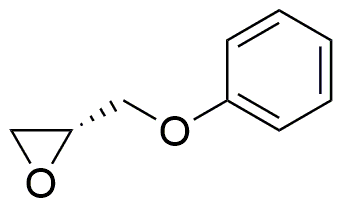(R)-Glycidyl phenyl ether is widely utilized in research focused on
- Adhesives and Sealants: This compound is commonly used in formulating high-performance adhesives, providing excellent bonding strength and durability for various materials, including plastics and metals.
- Coatings: It serves as a key ingredient in protective coatings, enhancing resistance to chemicals and environmental factors, making it ideal for industrial applications.
- Polymer Synthesis: Researchers leverage its epoxide group for the synthesis of specialty polymers, which can be tailored for specific properties, such as flexibility or thermal stability.
- Pharmaceuticals: In the pharmaceutical industry, it is used in drug formulation processes, where its reactivity can help in creating complex drug molecules with improved efficacy.
- Research and Development: This compound is a valuable tool in academic and industrial research, aiding in the development of new materials and chemical processes due to its unique chemical properties.
General Information
Properties
Safety and Regulations
Applications
(R)-Glycidyl phenyl ether is widely utilized in research focused on
- Adhesives and Sealants: This compound is commonly used in formulating high-performance adhesives, providing excellent bonding strength and durability for various materials, including plastics and metals.
- Coatings: It serves as a key ingredient in protective coatings, enhancing resistance to chemicals and environmental factors, making it ideal for industrial applications.
- Polymer Synthesis: Researchers leverage its epoxide group for the synthesis of specialty polymers, which can be tailored for specific properties, such as flexibility or thermal stability.
- Pharmaceuticals: In the pharmaceutical industry, it is used in drug formulation processes, where its reactivity can help in creating complex drug molecules with improved efficacy.
- Research and Development: This compound is a valuable tool in academic and industrial research, aiding in the development of new materials and chemical processes due to its unique chemical properties.
Documents
Safety Data Sheets (SDS)
The SDS provides comprehensive safety information on handling, storage, and disposal of the product.
Product Specification (PS)
The PS provides a comprehensive breakdown of the product’s properties, including chemical composition, physical state, purity, and storage requirements. It also details acceptable quality ranges and the product's intended applications.
Certificates of Analysis (COA)
Search for Certificates of Analysis (COA) by entering the products Lot Number. Lot and Batch Numbers can be found on a product’s label following the words ‘Lot’ or ‘Batch’.
*Catalog Number
*Lot Number
Certificates Of Origin (COO)
This COO confirms the country where the product was manufactured, and also details the materials and components used in it and whether it is derived from natural, synthetic, or other specific sources. This certificate may be required for customs, trade, and regulatory compliance.
*Catalog Number
*Lot Number
Safety Data Sheets (SDS)
The SDS provides comprehensive safety information on handling, storage, and disposal of the product.
DownloadProduct Specification (PS)
The PS provides a comprehensive breakdown of the product’s properties, including chemical composition, physical state, purity, and storage requirements. It also details acceptable quality ranges and the product's intended applications.
DownloadCertificates of Analysis (COA)
Search for Certificates of Analysis (COA) by entering the products Lot Number. Lot and Batch Numbers can be found on a product’s label following the words ‘Lot’ or ‘Batch’.
*Catalog Number
*Lot Number
Certificates Of Origin (COO)
This COO confirms the country where the product was manufactured, and also details the materials and components used in it and whether it is derived from natural, synthetic, or other specific sources. This certificate may be required for customs, trade, and regulatory compliance.


